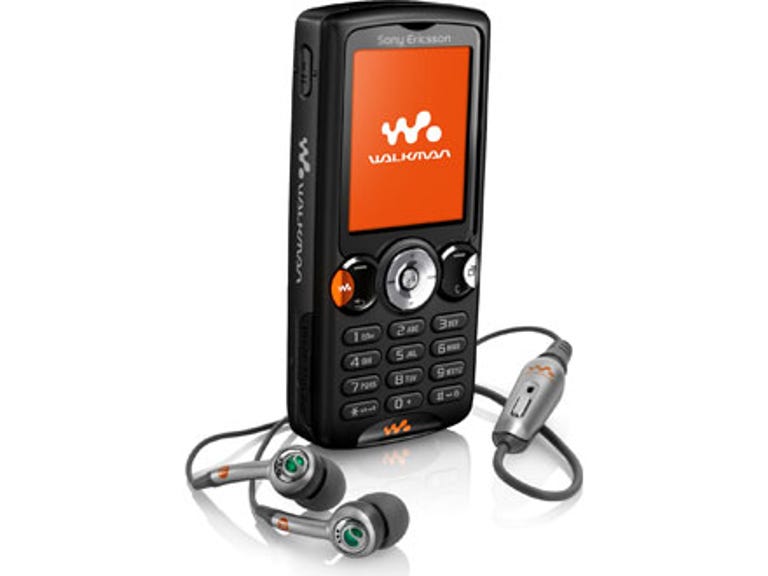 Why You Can Trust CNET
Why You Can Trust CNET Sony Ericsson W810i review: Sony Ericsson W810i
The W810i is Sony Ericsson's follow-up to the W800i Walkman mobile phone. It comes with a 512MB Memory Stick for music and a 2-megapixel camera for photos and Bluetooth -- thankfully, the phone is black this time around, not orange.
Design
The W810i is the fourth Walkman-branded phone we've seen so far and Sony Ericsson seems to be carefully refining its musical line of mobiles with each iteration, this time with an upgrade of the W800i. The W810i is very similar in appearance to its predecessor but it loses the W800i's Day-Glo orange case and adopts a more sophisticated black.
The Good
The Bad
The Bottom Line
Measuring 100 by 46 by 19.5mm and weighing in at 99 grams, it's pretty much the same size as the W800i -- well, Sony Ericsson has shaved 1mm off the thickness.
The numerical keys on the W810i are improved by being more separated than the keys on the W800i. Navigation is also easier due to a four-way rocker with a selection key in the middle, rather than a fiddly joystick. Customisable soft keys to either side of the navigation are arranged attractively in two circles, each containing three shortcuts. On the left set of soft keys is an orange "W" key that takes you into the Walkman menu where you can sort music on the phone by artist, playlist or track.
The camera shortcut key on the right side of the phone switches the W810i's display into a landscape-oriented electronic viewfinder when held down. The music shortcut key on the left acts as a play/pause button. Music can be played back through the supplied Sony bass-enhanced headphones, if connected, or through the W810i's built-in speaker.
Features
The W810i has an average-sized 176 by 220-pixel display capable of displaying up to 262,144 colours. Photos taken using the built-in 2-megapixel camera aren't done justice on the small display but can easily be transferred via Bluetooth or the supplied USB cable and viewed on a larger PC or laptop monitor.
Supporting four types of GSM networks, the W810 is crowned a quad-band or "world" phone, meaning you'll be able to make calls pretty much anywhere there is coverage. The W800i, by comparison, is a tri-band phone.
Regular POP3 and IMAP e-mail accounts can be accessed once set up and the W810i supports text and picture messaging. An FM radio, media player, video and sound recorder round out its abilities. Polyphonic and MP3/AAC ringtones are supported.
Sony Ericsson includes a 512MB Memory Stick Duo that slots into the side of the phone and stores around 120 songs or 1,300 pictures. There's only 20MB of internal memory on the W810i, down from the W800i's 34MB, but with a 512MB card bundled, we don't really care too much.
Performance
While we found Bluetooth handy for syncing contacts with our laptop, it's a good idea to use the USB cable for transferring music or photos. It took us about 35 minutes to transfer an hour's worth of music to the phone using Bluetooth.
Unlike the upcoming Sony Ericsson K800i, the W810i holds onto its predecessor's camera resolution of two megapixels. Its auto-focus mode works well even with macro shots, but we found the shutter lag annoying and pictures taken in low light came to be grainy -- night assist mode and using the built-in LED flash didn't do much to alleviate this. Provided there is adequate lighting, like on a bright, sunny day, the W810i's camera performs admirably.
Navigation of the W810 menus is pleasantly intuitive, like most recent Sony Ericsson phones. The extra screen resolution is a definite improvement when compared to previous models such as the T610 and T630. Themes can be applied to change the look and layout of the menus and Sony Ericsson pre-installs around 30 polyphonic ring tones to choose from. MP3s stored internally or on the memory card can also be used for ring tones.
Battery life isn't a concern with the W810i. We easily managed to get four or five days out of the phone between charges with average use of the phone's call, text and music features.
If you're looking for a phone with a good camera, a low-key profile that's not going to bulge in your pocket and adequate storage space for around six albums worth of music, we highly recommend the W810i. The interface and navigation isn't up to the standard of the iPod. It's only a second-generation (2G) phone, so as long as you're not fussed about video streaming and calling, it has features that will keep most users content. The W810i might run into some competition with Nokia's N91 when it is released mid-2006, as it sports a 4GB hard drive and 3G connectivity; unlike the W810i, it's fairly bulky.
Correction: Our original review stated that the W810i supports the Advanced Audio Distribution Profile (A2DP); however, it doesn't.


